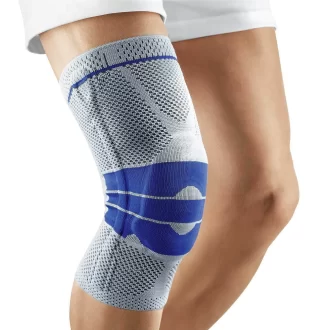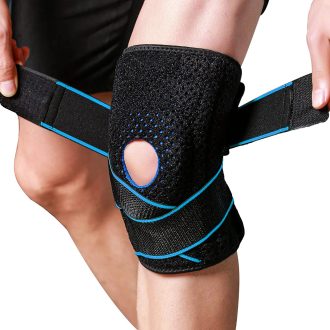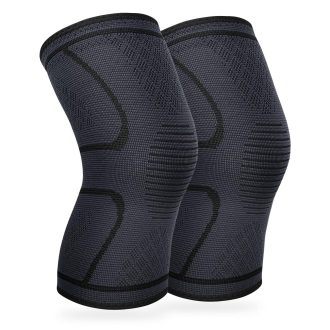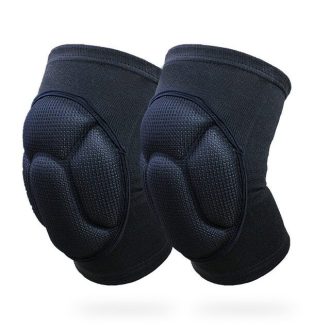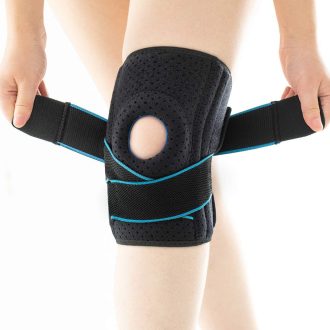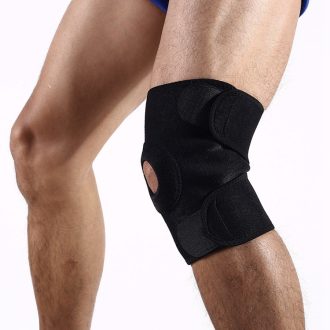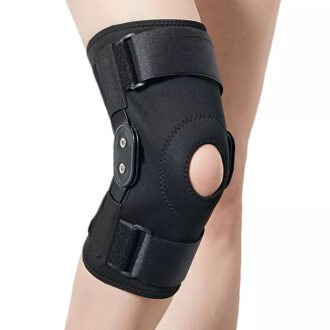No products in the cart.
Knee Support Sleeves
You’re looking for steady, comfortable support that fits into real life. Knee discomfort can make stairs, walks and simple tasks feel harder than they should. The right sleeve can add a more controlled feel without getting in the way. Our aim is to help you choose a sleeve that suits your routine.
Who it can help
Knee discomfort shows up in many ways, from a morning ache that eases with movement to sharper pains that limit stairs, squats or longer walks. Common contributors include gradual joint irritation, training spikes, awkward twists, or long days on your feet. A well‑sized sleeve may help you manage symptoms while you stay active; for personalised advice, speak to a physiotherapist or GP.
Common knee needs and conditions
How a knee sleeve helps day to day
A knee sleeve surrounds the joint with a consistent hold. By keeping soft tissues a little closer to the knee, small, unwanted shifts are reduced while bending and straightening remain free. The practical effect is a more controlled feel during steps, stairs and light activity.
The sleeve’s steady contact can sharpen your awareness of knee position. With clearer feedback, foot placement and leg alignment often become more predictable, which helps you avoid sudden twists or deep bends that tend to provoke discomfort when the area is sensitive.
Some sleeves use gentle shaping to encourage a smoother path for the kneecap. This is guidance rather than rigid bracing: the form presses slightly more in some areas and less in others so the kneecap tracks on a steadier route. Repeated short bends and everyday transfers often feel calmer with this kind of guidance.
Where present, soft cushioning zones spread contact over a wider area so pressure is not focused on one sore spot during brief kneeling or shallow bends. Breathable fabric qualities can help manage warmth across longer wear, keeping comfort steady under clothing.
These effects work together: even contact reduces small oscillations, guidance keeps movement on a comfortable path, and cushioning shares local pressure. The outcome is a knee that can feel more settled through everyday movement. A sleeve is not a cure, but it may help you manage symptoms while you follow a plan agreed with a clinician.
How to choose your sleeve
Support level and control
What it means: how firm the sleeve feels and how much it resists small, unwanted movements. When it matters: if the knee feels unsteady on stairs, slopes or uneven ground, a firmer option can add control; for desk days and gentle walks, a softer feel is often enough. Who it suits: lighter support for ease under clothing; more structured when you want extra steadiness. Takeaway: match support to your activity.
Fit and sizing
What it means: measurements around the lower thigh and upper calf determine size; the aim is an even hold without sharp pressure. When it matters: correct fit keeps contact consistent and helps prevent slipping or bunching. Who it suits: if you sit for long spells or have sensitive skin, prioritise comfort; for longer walks or classes, ensure it stays put through bends. Takeaway: measure as directed; choose snug, not tight.
Patella design (open vs closed)
What it means: an open‑patella design leaves the kneecap area clear; a closed design covers it. When it matters: if pressure over the kneecap bothers you, open designs reduce direct contact; if you prefer an uninterrupted feel, closed styles are more uniform. Who it suits: open for kneecap clearance; closed for all‑round coverage. Takeaway: pick the feel you prefer over the kneecap.
Fabric feel and heat management
What it means: thickness and knit affect softness, breathability and warmth. When it matters: if you run warm or wear the sleeve for longer spells, thinner, breathable options can feel fresher; for cooler settings or shorter bursts, a slightly thicker, softer fabric can feel reassuring. Who it suits: low‑profile fabrics under trousers; cushioned feel for shorter activity. Takeaway: match fabric to climate, clothing and wear time.
Activity and wear time
What it means: your routine—desk work with breaks, school runs, longer walks, classes or sport—guides the choice. When it matters: low‑to‑moderate activity usually suits lighter sleeves; sessions with more bending or uneven ground may call for a steadier option. Who it suits: easy‑on designs for daily wear; firmer designs for busier, on‑your‑feet days. Takeaway: let your main activity set the balance between comfort and control.
Quick picks for everyday routines
- Everyday comfort: low‑profile sleeves that sit smoothly under clothing for work, errands and steady walks.
- Steadier support days: more structured options for hills, stairs and longer outings when you want extra control.
- Activity sessions: sleeves suited to classes, gym circuits or cycling where repeated bends benefit from added reassurance.
- Sensitive spots: options with gentle cushioning to spread pressure during brief kneeling or shallow bends.
FAQs
Can I wear a knee sleeve all day?
Wear it during activities where you want support, and remove it for prolonged rest unless a clinician advises otherwise. If you notice numbness, tingling or increased discomfort, take it off and refit or switch size.
Will it fit under clothing?
Most sleeves are low‑profile and sit under trousers without bulk. If discretion matters, choose a thinner, smoother fabric and a close, even hold to reduce bunching.
How should it feel when on?
Snug, not tight. You should feel an even hold without sharp pressure. If there is numbness, tingling or colour change, remove it and refit more loosely or try a different size. See How to choose your sleeve for sizing tips.
Can I use a sleeve for running or gym work?
Often, yes. Many people use a sleeve during warm‑ups and steady sessions for a more controlled feel. Start with short, familiar sessions and remove it for prolonged rest. If it slips, check size and placement.
Can I wear it over a thin layer?
Next‑to‑skin contact gives the most consistent hold. You can wear it over a smooth, thin layer if preferred; make sure the layer underneath does not cause slipping and that the sleeve sits flat without folds.
Do I need one sleeve or a pair?
Choose one if support is needed on one side. A pair can suit people who want a balanced feel during symmetrical activities. Measure each leg individually; do not assume both are the same.
How long does a knee sleeve generally last?
How long a knee sleeve generally lasts depends on how often you use it, how it’s cared for, and how it’s put on and taken off. Gentle washing, air‑drying and avoiding sharp edges help. Replace it if it feels loose, starts to slip, or no longer provides an even hold.
Can I sleep in a knee sleeve?
As a rule, wear a sleeve during activity and remove it for prolonged rest or overnight unless a clinician advises otherwise. See Important information for safety notes.
Can I use a sleeve after surgery or with other supports?
After surgery, follow your clinician’s guidance before using any support. If combining with another aid, avoid stacking tight supports and check that circulation and skin comfort remain normal during use.
Ready to choose?
A well‑fitted knee sleeve adds steady, everyday support so steps, stairs and light activity feel more manageable. Pick the balance of comfort and control that suits your routine, with our money‑back guarantee for added reassurance. Browse the range.
Important information
Fit and sizing
- Measure as directed and select the size that gives a close, even hold.
- Centre the sleeve over the knee so any shaping aligns with the kneecap.
- If you feel numbness, tingling or coldness, remove the sleeve and refit more loosely or try a different size.
Usage and care
- Put the sleeve on over dry skin and smooth out folds so contact is even.
- Wear during activities where you want support; remove for prolonged rest unless advised otherwise by a clinician.
- Hand‑wash or gentle machine‑wash according to the label. Rinse well and air‑dry away from direct heat. Do not tumble‑dry.
- Store clean and dry, away from sharp objects.
Safety and suitability
- Do not use on broken or irritated skin. If you have a diagnosed circulation or nerve condition, or unexplained swelling, seek advice from a healthcare professional before use.
- Stop use and consult a clinician if pain, swelling, numbness or skin irritation increases.
- A sleeve supports comfort and confidence but is not a treatment. For personalised advice, speak to a physiotherapist or GP.
Returns and our guarantee
- Covered by our money‑back guarantee.
- Returns accepted within 30 days from the day the product is received in the post, in original condition.
- To start a return, contact our customer service team with your order details.
Knee Support Compression Sleeve For Running & Sports
- 1 x Knee Support Compression Sleeve by KneeReviver — unisex, low‑bulk support for running, sport and active days
- Sizes: M 31–35 cm, L 36–40 cm, XL 41–45 cm (measure around the centre of your knee for best fit)
- Flexible side stays for gentle, reliable lateral stability without restricting movement
- 3D graduated compression to ease discomfort and help control swelling after activity
- Patella‑support silicone pad to cushion the kneecap and improve comfort when bending
- Anti‑slip grippers to keep the sleeve in place during quicker efforts and direction changes
- Anatomical shaping and four‑way stretch for a smooth fit that moves naturally
- Breathable, moisture‑wicking nylon blend for cooler, drier wear across seasons
- Targeted cushioning at the kneecap and joint line to soften impact on sensitive areas
- Reinforced edging for lasting shape and durability; machine washable (air dry)
- Typical uses: runner’s knee (patellofemoral pain), ITB irritation, patellar/quad tendinopathy, bursitis, meniscal irritation, mild sprains, osteoarthritis
- Use alongside early recovery steps (rest, ice, elevation) when advised; not a substitute for medical care in significant injuries
- 30‑day Comfort & Fit Guarantee
£9.99£12.99inc VATKnee Stabilizer Brace Compression Sleeve for knee pain & post-op recovery
- 1x Open Patella Knee Stabilizer Brace Compression Sleeve for knee pain & post-op recovery
- For both Men & Women
- One size fits most
- Features adjustable knee wraps that keep the knee brace securely in place and stops it from moving around even during the most vigorous exercise routines
- Targeted support helps aid injury recovery by improving knee function and biomechanics through supporting the ligaments in your knee joint in the correct position and preventing excessive pressure and strain from causing further damage to your injured knee
- Provides soothing compression that helps ease knee pain and aches deep within your knee joint and help, reduce inflammation and swelling and promotes healing of damaged cells by boosting circulation of oxygen rich blood to your knee
- Ideal for athletes and runners who need extra support or want to prevent muscle fatigue in their knees
- Recommended for treating and preventing a whole host of different knee injuries and conditions including ACL, PCL & MCL knee injuries, Meniscus Tear, Runners & Jumpers knee, Patellar tendonitis, Patellar tendon sprains and strains, Chondromalacia or irritated knee cap, Gout, Arthritis, and Osteoarthritis
- Features inbuilt stabilizer springs either side of the knee brace that have been designed to help you to maintain correct knee movement and positioning and reduce pressure off your knee to stop knee sprains and strains from occurring
- The specially designed silicone gel knee pad absorbs shock helps, improves patella tendon stability and tracking and helps protect your patella tendon from collisions and shock
- Made from high quality Neoprene material with specially designed moisture wicking and ventilation technology to help keep your knee dry, sweat free and feeling comfortable for longer
- Includes a full 30 day money back guarantee!
£12.99£14.99inc VAT2x Compression Knee Support Sleeves
- Helps calm sore, puffy, or unsteady knees: KneeReviver Compression Knee Support Sleeves provide gentle, all‑round support and compression to help calm sore, puffy, or less steady knees when stairs, long days on your feet, or sport start to take their toll.
- Supplied as a left and right pair: Each pack includes 1 pair of sleeves shaped for the left and right knee, clearly marked L (left) and R (right), so you can support one knee or both and still keep a spare.
- For adults who need everyday knee support: Suitable for men and women who want soft knee support for daily activities, long shifts on their feet, regular running, or recurring niggles from old injuries, without the bulk of a rigid brace.
- Supports a range of knee conditions: Used as external support alongside medical care for ligament sprains (ACL, PCL, MCL), front‑of‑knee pain (runner’s knee, jumper’s knee, patellar tendon issues), meniscal irritation or tears (where your clinician agrees a sleeve is appropriate), and longer‑term wear‑and‑tear pain such as osteoarthritis or rheumatoid arthritis in the knee.
- Helps keep the knee better aligned: Contoured, left‑ and right‑specific design helps reduce inward or outward drift of the knee as you move, spreading pressure more evenly across the joint and easing strain on key ligaments, tendons, and joint surfaces.
- Gentle compression to ease tightness: Gentle, even compression around the joint helps limit fluid build‑up, ease that tight, full feeling, and make everyday, activity‑related aches more manageable while you work on strength and mobility.
- Comfortable for daily wear and exercise: Light, low‑bulk sleeves you can wear at home, at work, or during training sessions, so the knee feels supported during the movements you actually do – from walking and climbing stairs to runs and pitch or court sports.
- Stays in place when you move: Double silicone strips on the cuffs help hold the sleeves comfortably in position, reducing slipping or rolling down, even during harder exercise sessions.
- Breathable fabric that feels fresher for longer: Made from lightweight, breathable, moisture‑wicking fabric to help keep your knees and legs drier and more comfortable, even in warm gyms, crowded trains, or long days in uniform.
- Try them with a 30‑day guarantee: Includes a full 30‑day money‑back guarantee so you can see how your knees respond to using the sleeves, without a long‑term commitment if they are not right for you.
Size guide (measure around the knee area where the sleeve will sit):
- S: Length 27 cm; Top circumference 15 cm; Bottom circumference 13 cm; Leg (mid‑knee) circumference 30–34 cm
- M: Length 27 cm; Top circumference 16 cm; Bottom circumference 14 cm; Leg (mid‑knee) circumference 35–41 cm
- L: Length 27 cm; Top circumference 17 cm; Bottom circumference 15 cm; Leg (mid‑knee) circumference 42–47 cm
- XL: Length 27 cm; Top circumference 18 cm; Bottom circumference 16 cm; Leg (mid‑knee) circumference 48–55 cm
£11.99inc VAT1x Pair of Copper Knee Support Sleeves
- 1x Pair of Copper Knee Support Sleeves – Experience the power of real support with our copper knee support sleeves. These aren’t just any knee sleeves – they are a game-changer when it comes to enhancing your mobility, giving you the freedom to live an active life without the fear of pain or injury. Imagine being able to walk, run, or even just stand more confidently, knowing your knees are protected and supported. That’s what our knee sleeves can do for you.
- For both Men & Women
- Available in sizes Small, Medium, Large and XL
- Sizes are as following: Thigh Circumference: S 12.9-14.2 Inches, M 14.2-15.3 Inches, L 15.3-16.5 Inches, XL 16.5-17.7 Inches
- Recommended for treating and easing a wide range of injuries and conditions including Arthritis, Osteoarthritis, Sprains, Strains, ACL, PCL, and MCL knee injuries, Meniscus tears, Tendonitis, Runners & Jumpers knee
- Ergonomically designed to help protect, support and compress weakened and injured knees and is ideal for wearing for during the P.R.I.C.E injury recovery protocol for a faster and more effective injury recovery and rehabilitation
- Supports your knees in the correct position helping to improve the way your knees function and protect you from further injury whilst you recover
- Provides soothing targeted compression that helps ease pain deep within your knees, reduces inflammation and swelling and boosts blood flow to you knees to supply fresh oxygenated blood to your knees helping them to heal faster after sustaining an injury
- Made from a high quality blend of Copper and Nylon material which has antibacterial and moisture wicking properties that will help keep your legs sweat and odour free and feeling fresher for longer even during the most vigorous of exercise routines
- The lightweight, discreet and non bulky design makes these knee sleeves the ideal choice protecting and supporting your knees when running, cycling, rowing, exercising and playing sports such as Football, Rugby, Basketball and Volleyball
- Features non slip silicone strips that help to keep the sleeves securely in place and stop them from rolling up or down
- Includes a full 30 day money back guarantee for total customer peace of mind!
£19.99inc VATDance Knee Pads
- 1x Pair of Dance knee pads to help protect your knees whilst dancing
- One size fits all (Stretch fit)
- For both Men & Women
- Perfect for wearing whilst dancing, exercising, running and playing sports
- Protects your knees whilst kneeling on hard & rough surfaces by spreading pressure evenly across your knees and preventing the build up of pressure points when kneeling for long periods
- Specially developed foam material helps absorb shock and reduces the impact on your knees when falling on them
- Lightweight, breathable and non bulky design that does not restrict movement
- Supports your knees in the correct position helping improve the way your knees function and reduce strain and pressure off them to help prevent overuse injuries from developing when you are dancing or exercising
- Provides light soothing compression to your knees helping to boost blood flow to your leg muscles reducing muscle fatigue, soreness, inflammation and swelling whilst you dance
- Comfortable and easy to wear with an anti slip inner layer helps keep the knee pads securely in place preventing them from rolling up or falling down even during the most vigorous of dance routines
- Made from high quality, breathable and lightweight materials with moisture wicking properties that will help keep your legs dry and sweat free
- Includes a full 30 day money back guarantee!
£13.49inc VATKnee Compression Sleeve with adjustable knee wraps
- 1x Knee Compression Sleeve with Adjustable Knee Wraps designed to support, compress and protect your knee
- For both Men & Women
- One size fits all featuring adjustable knee warp straps that can quickly and easily adjusted for the perfect fit and compression
- Provides targeted support and compression to help treat and soothe knee pain and injuries
- Recommended for treating and easing a range of different injuries and conditions including ACL, PCL & MCL knee injuries, Chondromalacia or irritated knee cap, Runners & Jumpers knee, Meniscus Tear, Patellar tendonitis, Patellar tendon sprains and strains, Gout, Arthritis, and Osteoarthritis
- Can be used during the P.R.I.C.E injury recovery protocol for faster and more efficient injury recovery and rehabilitation
- Ideal for wearing whilst exercising, running and playing sports such as Football, Rugby and basketball to help better protect your knee from injury
- Supports and realigns your knee joint into the correct position helping reduce strain and pressure off your knee, increase mobility, improve knee function and biomechanical balance and reduce the risk of injury
- Provides soothing compression that helps boost blood circulation to your knee helping improve injury recovery by reducing inflammation and swelling, easing aches and pains and speeding up the natural healing process of damaged ligaments, tendons and muscles by supplying fresh oxygenated blood to your knee
- Metal spring side stabilizers help stabilize and hold your knee joint in the correct position preventing movement which could otherwise sprain, twist and damage key ligaments, tendons and cartilage found in your knee joint
- Features a silicone gel pad that supports your patella tendon and protects your knee cap from shock, collisions and impacts
- The breathable design and moisture wicking materials help keep your knee dry and feeling fresher for longer
- Includes a full 30 day money back guarantee!
£12.99£14.99inc VATArthritis Knee Brace
- 1x Arthritis Knee Brace
- For Both Men & Women
- Recommended for treating and easing knee Arthritis as well as ACL injuries, Strains, Sprains, Meniscus Tears, Bursitis and Tendonitis
- Helps protect your knee from further wear and tear by providing extra stability, shock absorption and helps promote better knee function
- One size fits all – Featuring two fully adjustable straps that wrap securely around your knee allowing to to adjust the knee brace quickly and easily to give you a custom level of Support, compression and protection
- Provides soothing compression that not only helps ease aches and pains deep within your knee joint but also boosts blood circulation to help speed up the natural healing process of knee injuries
- Ergonomically designed to ease pressure off your knee by supporting and correcting the biomechanics of your knee, helping you to avoid injury and improve your mobility and performance
- Made from lightweight Neoprene material with a breathable open patella design that keeps your knee sweat free and feeling comfortable and fresh even during the most vigorous of exercise routines
- The ideal choice for wearing whilst Running, Football, Rugby Basketball, Volleyball, Weightlifting, & Gym Workouts
- Includes a full 30 day money back guarantee!
£9.99inc VATPatella Support Knee Sprain Brace
- 1x Patella Knee Sprain Brace for injury recovery and pain relief
- For both Men & Women
- Available in sizes Medium, Large, XL & XXL
- Adjustable straps (Maximum Circumference Medium: 40cm, Large: 50cm, XL: 60cm, XXL: 70cm)
- Features two secure buckle straps that allow you to adjust the knee brace quickly and easily to the right fit and support that you require
- Ideal for recovery & rehabilitation of Anterior cruciate ligament (ACL) injuries, Medial Collateral Ligament (MCL) Injuries, Arthritis of the knee, Chondromalacia or irritated knee cap, Patellar tendon sprains or strains and Menisci tears
- Provides targeted and graduated compression that soothes aches and pains whilst improving blood flow to your injured knee joint helping speed up the natural healing process
- Features two removable metal hinges that help stabilize and protect your injured knee from further damage by improving the function and biomechanics of your knee joint
- Ideal for wearing whilst Running, exercising and playing sports such as Football, Rugby & Basketball
- The shock absorbing silicone gel knee pad cushions, supports and protects your knee knee cap and patella tendon
- Includes a full 30 day money back guarantee!
£15.49inc VAT

